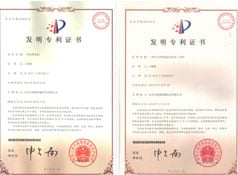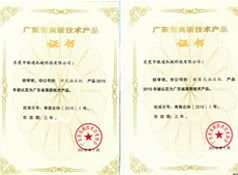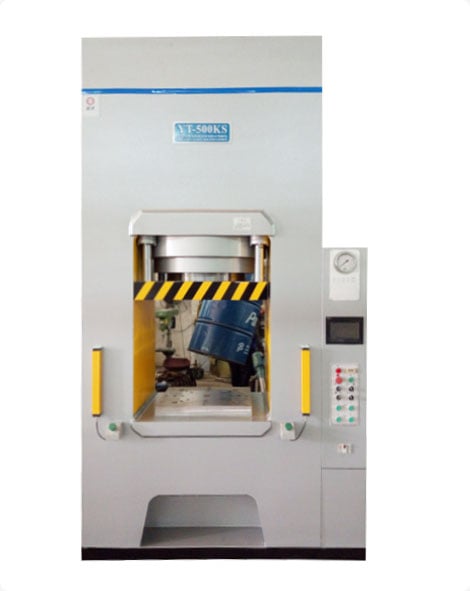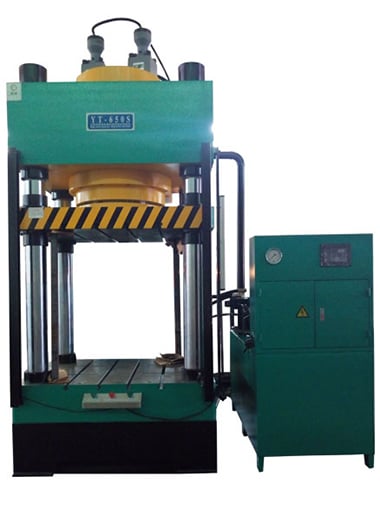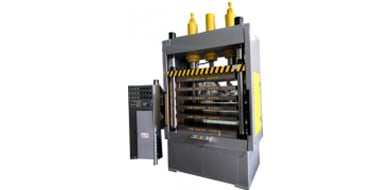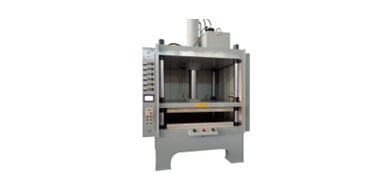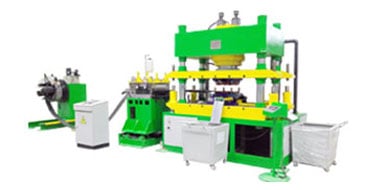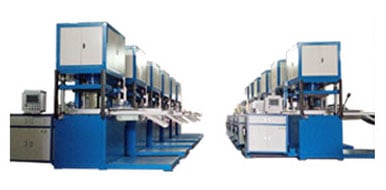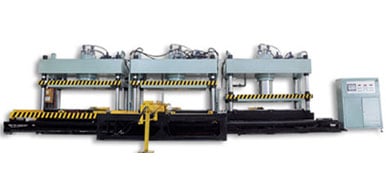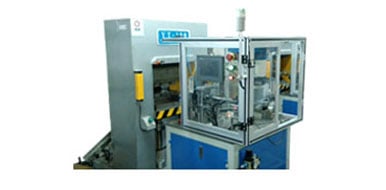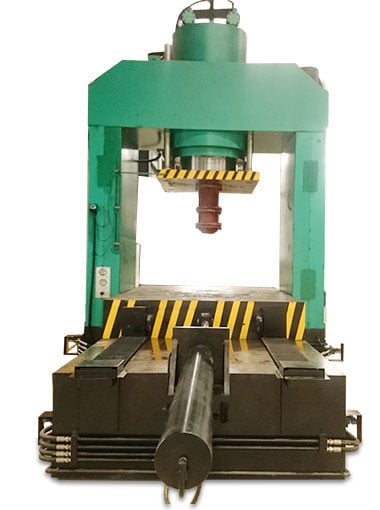Why Were Hydraulic Presses Made?
time:2023-06-04 views:(点击 1,010 次)Hydraulic presses are widely utilized by metal industries for crushing large pieces of nonliving material into flat shapes, similar to how pounding on metal with a hammer works. Energy is transformed into heat when its cylinders are compressed together - turning energy into heat energy!
Hydraulic presses are powered by pumps which pump oil from one cylinder into another cylinder and apply tremendous force by pressurizing both chambers simultaneously. Pumps may be hand, electric, or air operated.
They were invented by Joseph Bramah
Joseph Bramah (1749-1814) is best remembered as an inventor who created and popularized the hydraulic press, using hydraulic fluid to generate force that propels steel cylinders against materials at set pressures. This tool has proven itself useful in punching, deep drawing, metal forming and blanking processes as well. Pascal's law states that fluids transmit pressure evenly throughout a system.
Bramah used his knowledge of mechanics to develop the first hydraulic press, patenting it in 1795. Today, hydraulic presses serve an array of industrial functions like forming, stamping and cutting operations in factories worldwide.
Blaise Pascal first developed the basic idea behind hydraulic presses during his studies in fluid dynamics in France during the 1660s, when he conducted research into fluids, pressures and vacuums. Through these studies he identified an essential fundamental principle that underlies all hydraulic machines: fluids don't compress like air. With this discovery came hydraulics machines using similar principles as pneumatic systems but instead employ oil instead of water as their hydraulic fluid source.
Hydraulic systems offer several advantages over mechanical ones. They're less noisy, can transfer more power with less energy consumption, and produce greater pressures and forces than mechanical presses without compromising accuracy - features which make hydraulic systems particularly attractive in the automotive industry, where high pressures and speeds are essential to production.
The hydraulic press was an intricate machine requiring careful engineering. One of its major challenges was developing a seal capable of withstanding high pressures; Bramah attempted various approaches; but Henry Maudslay finally solved this challenge using a leather flap fitted into a recess in the piston to self-tighten under pressure - ultimately withstanding thousands of pounds of force!
Today, hydraulic presses are used in an array of applications ranging from sample preparation for Infrared (FTIR) spectroscopy to pressing clay into molds. A manual hydraulic press can generate up to 25 tons of pressure. When compressing samples such as KBr for analysis with this press, pellets may form which are then heated up in order to reveal their chemical components.
They are used in the automotive industry
Hydraulic presses have long been utilized by the automotive industry for various functions, such as molding, forming and punching. Their versatility enables them to produce high quality parts at reduced cost than other machines while remaining highly accurate with precise force capacities that make them suitable for making automobiles and heavy vehicles.
Joseph Bramah's first hydraulic press used water as its fluid power system. Over time he discovered that oil was superior because it's non-corrosive, lubricates hydraulic press components more effectively, can handle higher load capacities, is denser, and doesn't evaporate as rapidly. Hydraulic presses are operated using pumps which pressurize oil with pressurizing pressure that applies pressure directly onto pistons whose area and amount of hydraulic fluid used corresponds directly with piston pressure exertion.
Hydraulic presses have many applications across different industries, but their most notable use is metalworking. Their precision allows manufacturers to produce parts with tight tolerances and increase quality and efficiency while decreasing scrap material disposal costs and saving companies both money and resources.
Hydraulic presses not only reduce waste but also noise pollution, making them an excellent option for workplaces that must comply with government monitoring standards. Excessive noise can cause physical and mental strain leading to absenteeism and reduced productivity - however since a hydraulic press doesn't need elaborate gears, complicated brake systems, or motors to operate it produces significantly less noise than other machines.
There is a wide variety of hydraulic presses designed to fulfill various tasks. Some models are utilized for straightening out shafts or sheet metal that has become deformed, while others can shape raw materials into finished products. Laminating presses speed up applying polymers onto flat materials such as paper or metal quickly while mechanical presses generate power mechanically via crankshaft-powered ram cycles for each operation.
They are used in the food industry
The hydraulic press uses fluid power to exert immense amounts of force, making it an invaluable piece of machinery used across industries from junkyards to manufacturing plants. From crushing cars and turning metal sheets into large sheets to doing myriad other jobs - Joseph Bramah invented the hydraulic press in 1795 after Pascal discovered that even small amounts of pressure multiplied by affected surface area can produce enormous force; Joseph's invention enables manufacturers to shape materials that cannot be formed through traditional means such as punching and molding with greater ease than ever before.
A hydraulic press consists of a reservoir, pump that pressurizes hydraulic fluid and cylinder with piston. The pump creates a set amount of pressure - typically measured in tons - which is transmitted to material being pressed by piston. Furthermore, special oil is used to lubricate and protect its system from damage as oil doesn't evaporate quickly while handling heavier loads and staying cooler under high pressure than water does.
Hydraulic presses are commonly utilized by industrial users for performing various tasks such as cutting, molding and punching. Their efficiency allows manufacturers to save energy when compared with conventional mechanical presses while producing more precise presses with fewer moving parts and producing quieter operation without creating excessive noise pollution.
Food manufacturers use hydraulic presses to compress foods prior to packaging them, making transport simpler and extending shelf life by forcing out air and eliminating microbes that thrive in food products. Furthermore, hydraulic presses are employed by food industries for recycling special waste products like oil filters by compressing them down into smaller sizes while extracting unneeded oils; this enables reuse or disposal separately from normal waste streams.
Hydraulic presses can be utilized by construction firms in the industry to assess concrete's tensile strength. Furthermore, they can be used to mold and form components of buildings or bridges such as bases; testing this way helps meet building regulations while simultaneously saving money by decreasing cement usage.
They are used in the recycling industry
Hydraulic presses are extremely versatile tools, used in a variety of ways. From creating shapes, sizes and textures to compressing materials for storage or shipping purposes - hydraulic presses have many uses in industry across many sectors such as metal stamping, molding bending and pressing.
Hydraulic presses use a small piston to exert pressure on fluid in a chamber, which then creates an even greater force used against an underplate. The hydraulic press uses Pascal's theory of liquid pressure application; according to which, force applied will remain constant regardless of substance size; this allows users to generate large amounts of force quickly without resorting to costly gears or brake systems.
Hydraulic power has dramatically enhanced production processes and is used for various tasks, from metal stamping to forming and molding. Hydraulics play a significant role in industrial equipment such as cranes and printing presses; ship hulls; drilling and mining machinery; car manufacturing plants and even car sales offices use hydraulics extensively in their daily work operations. Furthermore, hydraulic motors offer quieter operation while producing up to 10 times more power.
One of the more frequently employed applications of hydraulics is in scrap baling, an integral step in recycling and repurposing old products and equipment. Scrap balers use machines capable of crushing cars, equipment, or obsolete machinery into compacted bales for easier transport and storage - an increasingly popular technology that companies can take advantage of to reduce waste.
Hydraulic presses can be easily modified for any production or assembly work by changing dies, pressure settings, stroke speed settings and process positions to suit individual production or assembly tasks. Their versatility has made them invaluable tools across industries from metal stamping and molding to food processing.
Link to this article: https://www.ihydraulicpress.com/yn/3439.html
Hot Articles
-
What Hydraulic Oil For Truss Press?
An individual worker lays each member of a truss on beds of presses arranged in the desired pattern, using companion plates 20 to operate both press……
-
What Ethnicity Are the People From Hydraulic Press Channel?
One of YouTube’s surprising success stories is an unlikely channel dedicated to crushing things with hydraulic presses. Each video shows objec……
-
Who Invented the Hydraulic Press For Cocoa Processing?
Cocoa processing is an integral component of chocolate manufacturing. From powder to bar production, this involves various steps involving multipl……
-
Where to Buy Hydraulic Press in Cape Town
Hydraulic presses are an integral component of many manufacturing applications, from moulding, shaping and shaping materials (usually metal) into di……
-
Blaise Pascal and the Hydraulic Press
Blaise Pascal was a French mathematician, physicist and philosopher renowned for his contributions in mathematics, physics and theology. Additiona……
-
Hydraulic Stamping Press
Hydraulic presses are essential tools in manufacturing. They produce parts for a variety of industries. Hydraulic presses utilize a ram and plunger ……
-
Where to Buy 10 Ton Hydraulic Press
When traditional tools won’t do, this manual hydraulic press offers up to 10-ton of pressure. Ideal for disassembling and installing bearings,……
-
What is the Maximum Hydraulic Press?
Hydraulic presses are used for forming, stamping and stamping parts in auto factories, electronics plants, heat treatment plants, gear factories and……
Latest News
-
What is the Difference Between a Hydraulic Press and an H-Frame Press?
What is the Difference Between a Hydraulic Press and an H-Frame Press? Hydraulic presses work by applying pressure to drive a steel cylinder, or ram……
-

Finding the Right Hydraulic Press Factory
Finding the Right Hydraulic Press Factory Hydraulic presses are a great way to apply high pressure to a material. They can be used for a variety of ……
-
Who Has a Hydraulic Press in Escanaba Michigan?
Hydraulic presses, widely employed in metalworking, can generate immense pressure. To do this, a hydraulic pump pressurizes oil into one cylinder th……
-
What to Use a Hydraulic Press For
Hydraulic presses use extreme force to bend, straighten, crush and flatten materials; they can even pierce and punch materials. H-frame and C-fram……
-
How Much Force Can a Hydraulic Press Exert?
Hydraulic presses are powerful tools that exert immense force onto an object. They have become a go-to choice for industrial uses due to their abili……
-
Where to Buy Hydraulic Press Oil
Hydraulic presses play an integral role in many industrial processes. They shape metal components while also serving to crush waste material. Howe……
-
Why is a Hydraulic Press So Strong?
A hydraulic press is a machine that employs Pascal’s principle to generate tremendous force. Consisting of two cylinders – one smaller t……
-
How to Choose the Right Hydraulic Press
When shopping for hydraulic presses, there are plenty of models to choose from – each with their own distinct advantages. Be sure that the one……


